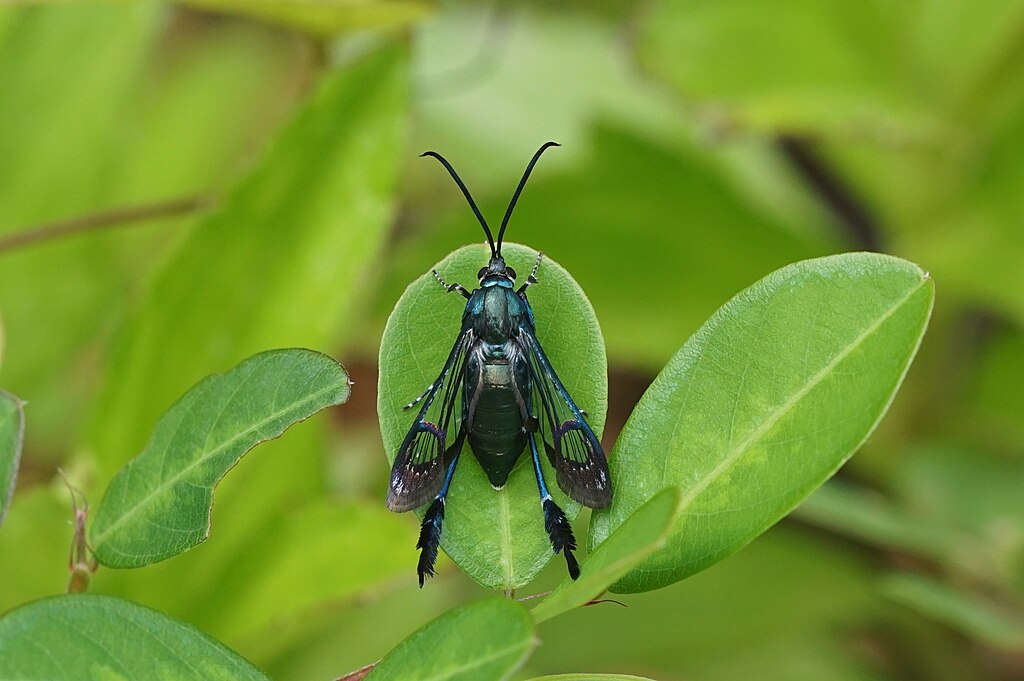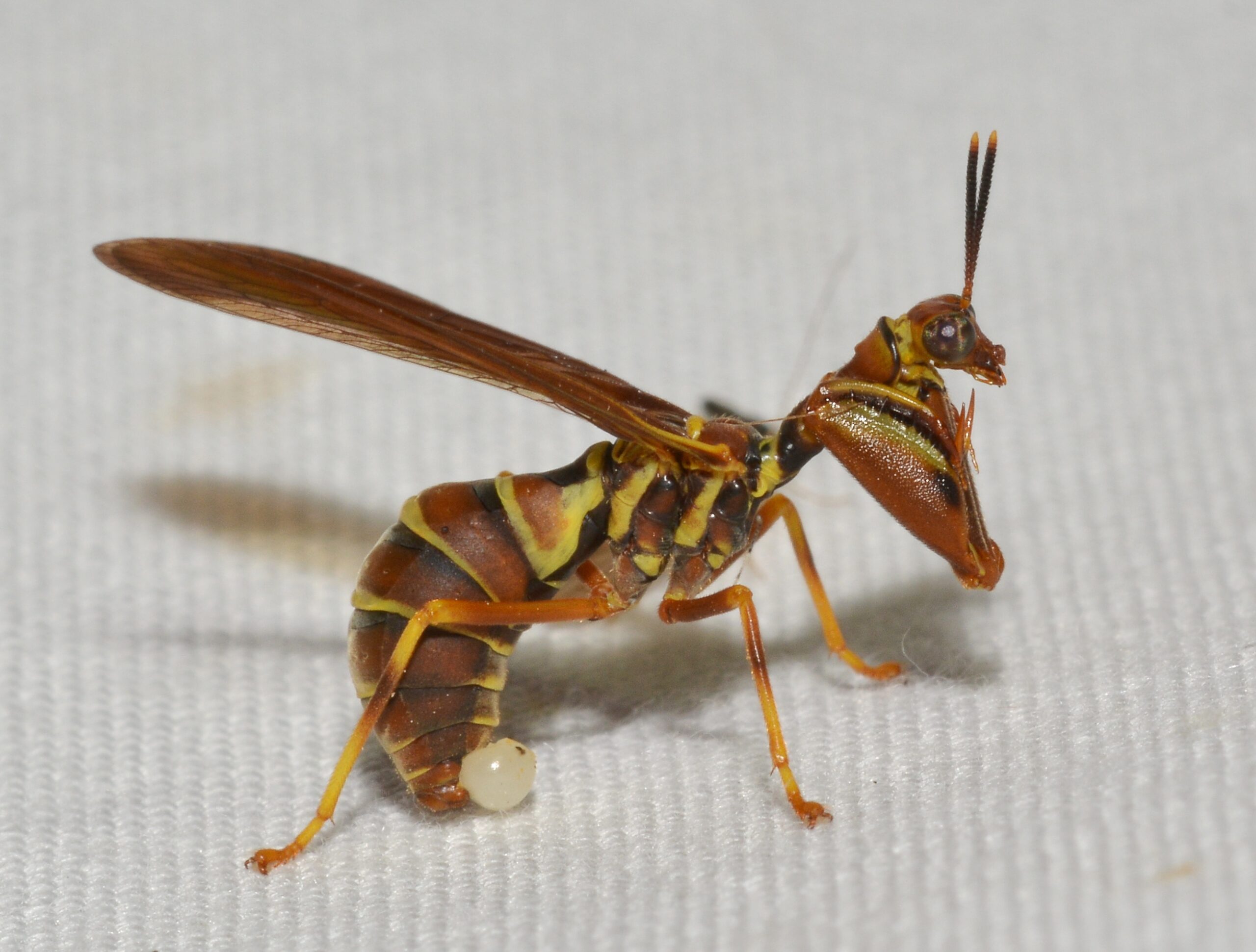You’re enjoying a peaceful evening on your porch when suddenly a yellow and black striped insect buzzes past your head. Your heart races as you duck instinctively, convinced you’ve just encountered an aggressive wasp. But wait – something about its flight pattern seems off. The way it moves, the sound it makes, even how it hovers near that outdoor light feels different. What if I told you that fearsome “wasp” might actually be one of nature’s most talented impersonators, wearing a costume so convincing it could fool even experienced naturalists?
The Art of Batesian Mimicry

Nature has produced some truly remarkable actors, and moths are among the most skilled performers in the animal kingdom. Batesian mimicry, named after naturalist Henry Walter Bates, describes how harmless species evolve to look like dangerous ones for protection. It’s like wearing a superhero costume to scare away bullies – except these moths have been perfecting their disguise for millions of years. The clearwing moths represent some of the most impressive examples of this evolutionary strategy. These incredible insects have traded their typical fuzzy, scale-covered wings for transparent ones that gleam like glass in sunlight. Their bodies sport the classic yellow and black warning colors that scream “danger” to potential predators.
Meet the Hummingbird Clearwing

The hummingbird clearwing moth might just be the ultimate shape-shifter of the insect world. During daylight hours, this remarkable creature hovers at flowers like a tiny hummingbird, its wings beating so fast they become invisible blurs. Its body displays bold yellow and black stripes that perfectly mimic those of a hornet or yellowjacket wasp. What makes this moth even more convincing is its behavior. Unlike most moths that are active at night, hummingbird clearwings feed during the day, boldly visiting flowers in broad daylight. They even make a slight buzzing sound as they fly, adding an auditory element to their wasp impersonation. Watch one feed on bee balm or phlox, and you’ll swear you’re observing a small hornet gathering nectar.
The Snowberry Clearwing’s Yellow Jacket Act

If the hummingbird clearwing is impressive, the snowberry clearwing takes wasp mimicry to an entirely different level. This moth has evolved such a convincing yellowjacket disguise that even entomologists do double-takes when they first encounter one. Its yellow and black banded abdomen looks identical to that of its stinging model, complete with the narrow waist that gives wasps their distinctive silhouette. The snowberry clearwing’s transparent wings add another layer of authenticity to its disguise. Real wasps have clear, membranous wings, and this moth has evolved to match that exact appearance. Even its antennae are shorter and more wasp-like than those of typical moths, showing how evolution has fine-tuned every detail of this incredible costume.
The Hornet Moth’s Massive Deception

Some moths don’t just pretend to be wasps – they impersonate the biggest, most intimidating ones. The hornet moth has evolved to mimic the fearsome European hornet, complete with a robust body that can span nearly two inches. This isn’t just about looking scary; it’s about survival in a world where being mistaken for a dangerous insect can mean the difference between life and death. The hornet moth’s disguise includes more than just coloration. Its body shape, the way it moves, and even its flight pattern all mirror those of a real hornet. These moths have been observed causing genuine panic at outdoor gatherings, with people fleeing what they believed was an aggressive hornet. The irony is that these impressive insects are completely harmless – they can’t sting, bite, or cause any harm whatsoever.
Why Moths Choose the Wasp Costume

The answer lies in the power of reputation. Wasps, hornets, and yellowjackets have spent millions of years building their fearsome image through painful stings and aggressive behavior. They’ve essentially created a brand that screams “stay away,” and clever moths have learned to exploit this hard-earned reputation. It’s like wearing a famous designer label – the recognition is instant and the respect immediate. This evolutionary strategy makes perfect sense when you consider the alternatives. Moths that rely on camouflage must remain perfectly still and hope predators don’t notice them. Those that choose bright warning colors must actually be toxic or dangerous to back up their threats. But wasp mimics get the best of both worlds – they can fly around in broad daylight, confident that their costume will keep most predators at bay.
The Science Behind the Stripes
The yellow and black warning coloration seen in wasp-mimicking moths isn’t random – it’s one of nature’s most universal danger signals. This color combination appears across countless species, from poison dart frogs to coral snakes, creating what scientists call an “aposematic” warning system. Predators learn to associate these colors with pain, toxicity, or danger, making them incredibly effective deterrents. Research has shown that birds and other predators avoid yellow and black striped insects even when they’ve never encountered the real dangerous species before. This suggests that the fear response to these warning colors might be partially innate, making wasp mimicry an even more powerful survival strategy. The stripes work like a universal language that says “don’t mess with me” in terms every predator understands.
Transparent Wings: The Ultimate Disguise

The evolution of transparent wings in clearwing moths represents one of nature’s most remarkable adaptations. These moths have essentially made their wings invisible by losing the scales that typically cover moth wings. The result is a wing that looks remarkably similar to those of wasps, hornets, and other hymenopterans. Creating transparent wings isn’t as simple as just removing scales. The wing membrane itself must be perfectly clear, without any pigmentation or structural elements that would make it visible. Some species have even evolved specialized microscopic structures on their wings that reduce reflection and increase transparency. It’s like having built-in anti-glare coating on their wings.
Behavioral Mimicry: Acting the Part

Looking like a wasp is only half the battle – these moths must also act like wasps to complete their disguise. Many wasp-mimicking moths have evolved behaviors that perfectly match their models. They fly during the day when wasps are active, visit the same types of flowers, and even move with the same confident, purposeful flight patterns that characterize real wasps. Some species take behavioral mimicry even further. They’ll hover aggressively near flowers, mimicking the territorial behavior of real wasps. Others have learned to make buzzing sounds that closely match those of their wasp models. Watch a hummingbird clearwing feeding, and you’ll notice it doesn’t just look like a small hornet – it acts like one too.
The Evolutionary Arms Race

The relationship between wasp-mimicking moths and their predators represents an ongoing evolutionary arms race. As predators become better at detecting fake wasps, the moths must evolve more convincing disguises. This has led to incredibly sophisticated mimicry systems where every detail, from antenna shape to flight speed, has been fine-tuned over millions of years. Some recent research suggests that certain predators are beginning to learn the difference between real wasps and their moth mimics. This is driving the evolution of even more convincing disguises, with some moths now mimicking multiple wasp species or developing regional variations of their costumes. It’s like a biological version of keeping up with the latest fashion trends.
Geographic Variations in Wasp Mimicry
Wasp-mimicking moths don’t use a one-size-fits-all approach to their disguises. Different populations of the same species often mimic different local wasp species, creating regional variations in their appearance. A hummingbird clearwing in Maine might look slightly different from one in Georgia, each perfectly adapted to mimic the most dangerous wasps in their respective regions. This geographic variation in mimicry patterns provides fascinating insights into how evolution works at the local level. Moths in areas with more hornets tend to be larger and more orange-colored, while those in yellowjacket territory are smaller and more distinctly yellow and black. It’s like having different costume departments for different theaters, each one perfectly suited to its local audience.
The Role of Learning in Predator Avoidance

The success of wasp mimicry depends heavily on predators learning to associate certain visual cues with danger. Young birds that have never been stung by a wasp don’t initially avoid wasp-like insects. However, after one or two painful encounters with real wasps, they quickly learn to avoid anything that looks remotely similar. This learning process is crucial for the success of moth mimics. If predators didn’t learn to avoid wasp-like insects, the mimicry would be useless. The fact that this learning is so strong and persistent means that even perfect moth mimics benefit from the painful lessons that predators learn from encounters with real wasps. It’s a system where the dangerous species do the “teaching” while the harmless mimics reap the benefits.
Other Insects That Wear Wasp Costumes

Moths aren’t the only insects that have discovered the power of the wasp costume. Hover flies, also known as flower flies, are perhaps even more convincing wasp mimics than most moths. These flies have evolved yellow and black stripes, transparent wings, and even the ability to hover like small helicopters – all to mimic wasps and bees. Beetle species have also gotten in on the act, with some longhorn beetles evolving wasp-like coloration and behavior. Even some true bugs have developed wasp mimicry, creating an entire community of insects all wearing variations of the same protective costume. It’s like a biological costume party where everyone chose the same theme because it works so well.
Conservation Implications of Mimicry

The intricate relationships between wasp-mimicking moths and their models have important conservation implications. If real wasp populations decline due to pesticide use or habitat loss, the effectiveness of moth mimicry could be reduced. Predators that encounter fewer real wasps might be less likely to learn to avoid wasp-like insects, potentially leaving moth mimics more vulnerable. This interconnectedness shows how conservation efforts must consider entire ecological communities, not just individual species. Protecting wasp-mimicking moths means also protecting the wasps they mimic, along with the predators that learn to avoid both. It’s a reminder that nature’s relationships are often more complex and interdependent than they initially appear.
Future Research and Discoveries

Scientists continue to discover new aspects of wasp mimicry that challenge our understanding of how these systems work. Recent research has revealed that some moths can actually adjust their mimicry based on local conditions, becoming more or less wasp-like depending on the predator pressure in their environment. This behavioral flexibility adds another layer of sophistication to an already impressive evolutionary strategy. Advanced imaging techniques are also revealing new details about how transparent wings work and how moths achieve their remarkable wasp-like appearance. Some researchers are even studying these natural systems to develop new materials and technologies inspired by the moths’ invisible wings. The future promises even more surprising discoveries about these master impersonators.
Conclusion

The world of wasp-mimicking moths reveals nature’s incredible capacity for deception and adaptation. These remarkable insects have evolved some of the most convincing disguises in the animal kingdom, fooling predators and humans alike with their perfect wasp costumes. From the transparent wings that shimmer like glass to the behavioral adaptations that complete their act, these moths demonstrate that sometimes the best defense is a really good offense. Next time you see what looks like a wasp hovering at your garden flowers, take a closer look – you might be witnessing one of evolution’s greatest magic tricks in action. What other incredible disguises might be hiding in plain sight in your own backyard?

